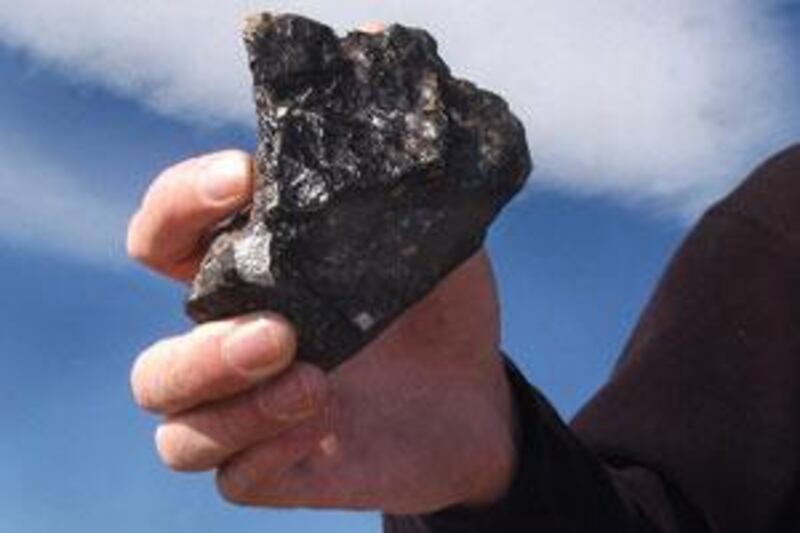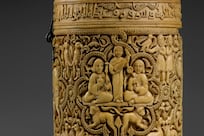Some odd bits of rubble are expected to make Rob Elliott richer to the tune of more than £250,000 (Dh1.5 million) later this week. Collectors from around the world are likely to take a keen interest in the chunks of rocks, which come up for auction in Edinburgh, Scotland, on Tuesday, as their humdrum appearance belies their dramatic origin. They are meteorites, remnants of catastrophic events in our solar system that have made landfall on Earth.
Most of them come from the asteroid belt, the debris-strewn region between the orbits of Mars and Jupiter. A few have arrived here from the Red Planet itself or even the Moon, having been thrown off their parent planets by violent impacts and put on trajectories that cross our own. Most burn up in our atmosphere, appearing as "shooting stars", but some survive - becoming a handy source of extraterrestrial material for astronomers.
Meteorites also provide a valuable resource for social psychologists, as they demonstrate a phenomenon that could once have led Mr Elliott to face a police investigation. For until the 19th century, the idea that stones could fall from the sky was regarded as wilfully false, and anyone putting such stones on display could expect stern treatment from the authorities. When the prestigious Institut de France heard reports of thousands of stones landing in a village in Normandy on July 17, 1803, it dispatched one of its leading scientists to investigate the mass delusion. Jean-Baptiste Biot did a thorough job, but returned with bad news for his masters: the reports were correct.
Mr Biot's investigation marked a turning point in the attitude of scientists towards meteorites. It also put them on the long road to recovery from the psychological condition that had blighted them for centuries. Known as cognitive dissonance, it was first identified in the late 1950s by the psychologist Leon Festinger at Stanford University, California. Put simply, it emerges whenever people find themselves confronted by two mutually contradictory ideas. According to Mr Festinger, the resulting mental dissonance is so unsettling that people resort to all kinds of strategies to alleviate it - including the rejection of "inconvenient" facts.
A classic example of cognitive dissonance is smoking, in which otherwise intelligent people indulge in a habit with proven health risks. One way of resolving the dissonance is simply to quit smoking, but many chose another strategy, puffing away while dismissing the wealth of evidence that smoking leads to an early grave. In the case of meteorites, during Mr Biot's time scientists simply did not believe in cosmic bombardment. The idea that stones could fall from space smacked of superstition. For centuries, scientists had opted to deal with the threat to their view of the world by simply ignoring evidence that did not fit. After Mr Biot's investigation, this was no longer possible: his reputation, and the sheer weight of evidence, forced a rethink.
It was far from comprehensive, however. A century later, attempts to link Arizona's famous one-kilometre wide Barringer crater to a cosmic impact were rebuffed by scientists unable to handle the idea of gigantic meteorites. As recently as the 1980s, evidence that a titanic meteorite up to 10km across struck the Earth 65 million years ago near the Gulf of Mexico, tipping the dinosaurs into extinction, was dismissed by one leading American scientist as "codswallop".
No serious scientist would today deny that the Earth is subject to bombardment by cosmic debris. Their problem now is to persuade others of that fact. Despite repeated warnings that it is only a matter of time before our planet is struck by a devastating meteorite, attempts by astronomers to quantify the threat have been undermined and underfunded. Last week a report by the US National Academy of Sciences warned that the world's only serious attempt to track down such objects is woefully underfunded. Four years ago the US space agency Nasa was directed by Congress to find 90 per cent of the estimated 20,000 objects believed to pose such a threat, producing a catalogue of them by 2020. So far, the agency has tracked down around 6,000 - less than one-third of the total.
To meet its target, Nasa needs funds averaging US$80 million (Dh300m) over the next 10 years. This seems a small price to pay for finding out more about so devastating a threat, but it is unlikely to be forthcoming. And the reason again has its roots in cognitive dissonance. Like smokers who rationalise their habit by arguing that "well, we have got to die of something", politicians can always point to more pressing hazards demanding publicly funded study.
As ever, the cure lies in evidence so compelling that it overwhelms any attempt to fudge the issue. Obviously the existence of huge primordial craters has not done the job, nor the constant bombardment of the Earth by small meteorites. So what would prompt some real action? Astronomers thought they had what they needed in 1994, when a comet, Shoemaker-Levy 9, struck Jupiter with greater violence than the detonation of the entire world's nuclear arsenal. Yet after a flurry of headlines, interest in cosmic impacts faded. When Jupiter was struck by a similar object last month, there was hardly a word about its significance for the Earth.
A direct threat to our planet might seem a more promising attention-grabber, but again recent events suggest otherwise. Last October a chunk of asteroid code-named 2008 TC3 smashed into the Nubian desert in Sudan with the violence of a tactical nuclear weapon. The event prompted a flurry of headlines, followed by silence. Are we sleepwalking into a disaster? Perhaps: unless astronomers are funded to assess the size of the threat, we will never know. As things stand, it is entirely possible that this week's auction could be cancelled due to the arrival of a meteorite rather larger than any found in the catalogue.
Robert Matthews is Visiting Reader in Science at Aston University, Birmingham, England






